2014
Re-evaluating Winter Rye
Over the past two seasons, we have been taking another look at winter rye and how it fits in with our established cropping systems in North Dakota. Due to its early maturing nature, thick canopy, and broadleaf weed suppressing ability (allelopathy), we have found a good synergy between winter rye and soybeans produced during the same growing season. The goal of much of this research has been evaluating how to best use rye before and after soybean planting to maximize production of both crops and/or get multiple benefits from those same acres. Here is a list of reasons why these crops “play nice” together:
Rye Soybeans
Early maturing Can be planted late
Cool season Warm season
Early canopy establishment Mid-late summer canopy
Moderately salt tolerant Salt sensitive
Broadleaf weed suppression Herbicide resistant weeds grow in soybeans
Resistant to soybean planting operation Appears unaffected by rye after planting
One major focus of the study is to determine the best method and timing for rye removal. In our study we do the following:
- Tillage (disking may be the best) prior to soybean planting
- Glyphosate burndown prior to soybeans planting
- Mowing the rye at anthesis – after soybean planting
- Taking the rye as a forage at anthesis – after soybean planting
- Applying glyphosate at anthesis – early post-emergent soybean timing
- Harvesting the rye as grain – harvesting the soybeans as grain later too.
We will determine which combination of removal methods and timings will 1. Provide the best weed control and 2. Provide the greatest returns for both crops. We’ve had good luck producing these crops together the last few years and hope to have more data generated over the next two years to determine the feasibility of each combination. Here are a few photos of what we are seeing.
Sourcing winter rye seed:
Due to the recent interest in winter rye, demand for seed is increasing. Rye seed can be difficult to source locally as few people produce seed at this time and no certified rye has been planted in North Dakota since 2004. Certified seed can still be sourced from other states by searching through their respective State Certification list of seed growers. Common seed can be purchased by local producers although variety purity may be unknown. Rye can also be purchased through seed houses, although careful selection is needed as many times it is listed as VNS (variety not stated) and the winter survival may not be suited for North Dakota. Currently, an experimental line of winter rye is being developed by NDSU at the CREC with the hopes of releasing an adapted variety that will be available to producers in the future.
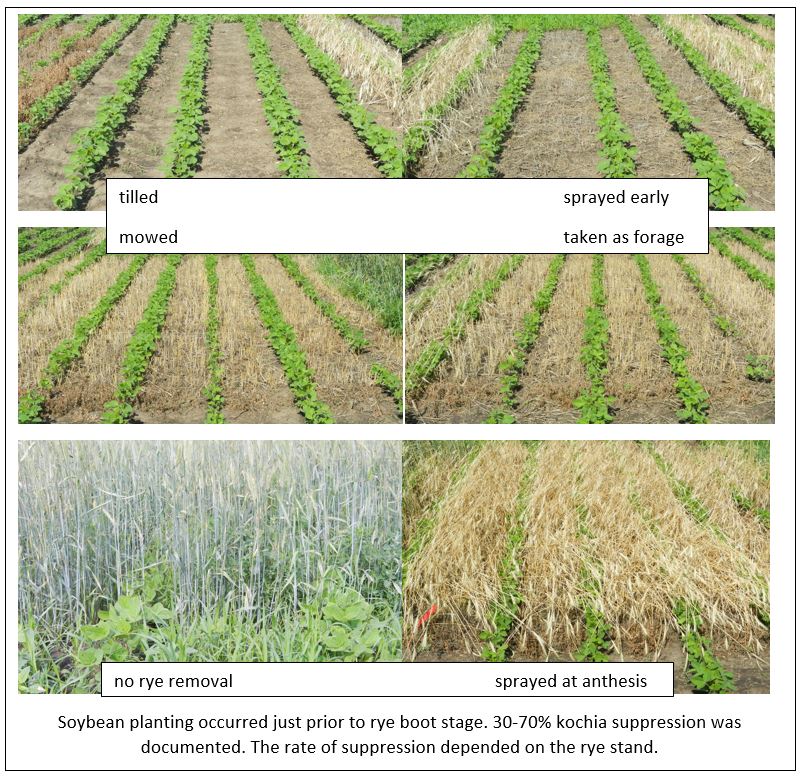
Mike Ostlie
Agronomist
Steve Zwinger
Agronomy Research Specialist
Producer Cattle Feedout Projects at CREC Livestock Unit
Feeding cattle from weaning to harvest is wide spread throughout the mid-west and southern plains. North Dakota has a large backgrounding and stocker industry with a smaller feeding to finish industry. The feeding industry has potential for growth with recent feedyard expansion throughout North Dakota.
To aid the industry in growth, cattle feedout projects were developed at the NDSU Carrington Research Extension Center (CREC) using producer cattle. Producers can consign groups of their cattle in either October or May/June. The cattle are fed to finish at the CREC Livestock Unit. Cattle are routinely weighed and carcass information is collected individually. The cattle are marketed as a group with individual animal gross return determined via the carcass value. Feeding costs are deducted from harvest value.
Producers are provided with monthly individual weights, carcass information, and detailed expenses and returns.
Enrollment in the project is either fall or summer. The fall feedout project enrollment is via the Dakota Feeder Calf Show at Turtle Lake, ND in mid –October on the third Saturday. Consignment groups are 3-4 head of calves. The summer feedout project - ND Angus University – takes enrollment in late May/early June. Consignment groups are 5-30 head of calves. 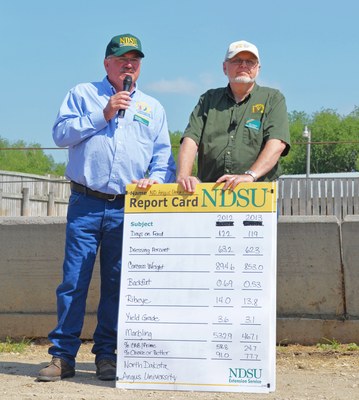
Presently, the ND Angus University cattle averaged 5.05 pounds per day and 1028.4 pounds per head at the last weigh period.
In 2013 the ND Angus University cattle were on feed for 119 days, 853 pounds carcass weight, 0.53 inch backfat, 13.8 square inch ribeye, 24.7% Certified Angus Beef or Prime, and 77.7% USDA Choice or better. Feed cost of gain was 88.5 cents per pound while to total cost of gain (without interest) was $1.07 per pound.
Each producer receives a detailed report for each of their animals in the project. Using an estimated beginning value for the cattle, overall profit in 2013 was $99.47 per head for the ND Angus U feedout.
If interested in learning more about the feeding performance and value of your cattle, contact Karl Hoppe, Vern Anderson, or Chanda Engel at 701-652-2951.
Karl Hoppe
Area Specialist, Livestock Systems
Managing Hay Resources: When the Sun Won’t Shine!
While we have been blessed with plenty of moisture in most parts of North Dakota this spring and early summer it has made “making hay while the sun shines” fairly challenging.
Putting up the desired quality of hay involves cutting at the proper stage of maturity and being able to get it dry enough to bale and stack. Delays in cutting may slightly increase yields but significantly reduce quality as plants become more mature, however letting hay lay in a windrow and get wet also reduces the quality and yield of the finished product. The primary weather related losses are caused by:
- Leaching of soluble carbohydrates, proteins, minerals, and vitamins.
- Repeated re-wetting can increase and prolong plant respiration further increasing nutrient and yield reductions.
- Mechanical handling (raking and tedding) to improve dry down increases leaf shattering and subsequent quality and yield losses.
- Wet hay increases mold growth and microbial activity which further reduce quality and increase plant nutrient breakdown.
- Reduced aesthetic appearance due to bleaching, not a good indication of quality losses.
Rain during hay dry down is not as detrimental on quality as rain events that occur as the hay gets closer to being ready to package. Soaking rains that fall more gently, tend to leach a greater amount of nutrients. Generally crude protein levels are only slightly affected when field cured hay gets rained on prior to baling. However digestibility can be reduced significantly from 72% when cured without rain, down to 49% after 2.4 inches of rain on nearly dry hay (Collins, 1983). Conversely, both neutral detergent fiber and acid detergent fiber can increase over 20%, as they are comprised of mostly structural carbohydrates (Collins, 1983). Once cut and in a package we can’t change the losses that occurred but we can quantify them and manage the hay to best match the nutrient needs of the livestock intended to consume it. A proper evaluation of hay quality involves both a visual and a laboratory analysis.
Visual Evaluation
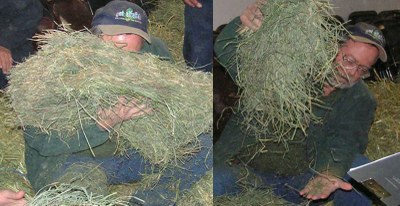 The visual evaluation, often referred to as a sensory evaluation, involves using both sight and smell. Visually inspect for stage of maturity, forage species, and any foreign matter (Figure 1). Odor can indicate heat damage (sweet tobacco or caramel like smell) and presence of mold. Color is not a good measurement of quality, a sun bleached hay can still be higher quality than another hay that is bright green. Laboratory Analysis of forage quality is the best and only accurate indication of how a hay will meet livestock nutrient needs.
The visual evaluation, often referred to as a sensory evaluation, involves using both sight and smell. Visually inspect for stage of maturity, forage species, and any foreign matter (Figure 1). Odor can indicate heat damage (sweet tobacco or caramel like smell) and presence of mold. Color is not a good measurement of quality, a sun bleached hay can still be higher quality than another hay that is bright green. Laboratory Analysis of forage quality is the best and only accurate indication of how a hay will meet livestock nutrient needs.
Figure 1. Sensory evaluation of hay smelling and visually inspecting hay for dust and foreign material.
Laboratory Evaluation
Proper sampling technique is important in getting an accurate laboratory analysis result. Grab samples are highly inaccurate and frankly a waste of your time, effort and money. To get the best analysis, a hay probe with a sharp tip (Figure 2) should be utilized to properly core and sample at least 20 bales within the same lot of hay. Both Near Infrared (NIRS) and wet chemistry are great analysis procedures, as long as a reputable forage lab is utilized. To select a lab see the National Forage Testing Association (NFTA) link below. Once you get the results back, purchase and organize your hay resources based on the nutrient requirement needs for the type of livestock, age, and stage of production (see link below for more information on understanding and interpreting forage analysis results).
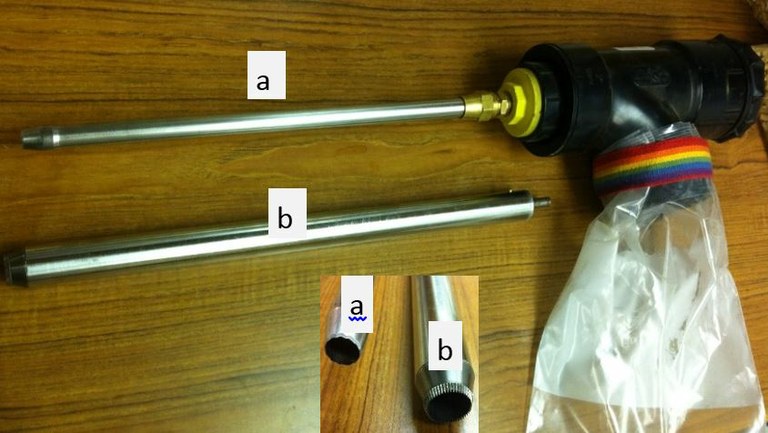
Figure 2. Example of two hay probe types. (a) Push type multi-core sampler with beveled, re-sharpenable tip (star quality samplerTM);
(b) Single core drill attachment, PensylvaniaTM type sampler with serrated tip.
Links for Additional Information and Resources:
National Forage Testing Association; Sampling Feeds for Analysis; Hay probe links; Selecting a laboratory; Interpreting Forage Analysis; Preventing Hay fires
Chanda Engel
Livestock Research Specialist
Weed Watch in Central ND
Now is the time of year when weed management decisions directly affect next year’s bottom line.
The plants that have escaped control measures and are still actively growing now, generate thousands to millions of seeds, depending on species and level of control. Even taking steps that reduce seed set, without completely killing the plant will make a big difference the following years; it’s really a numbers game with annual weeds. Imagine a kochia plant which can produce 50,000 seeds per plant. Achieving 70% control (many branches burned off with a PPO product like Flexstar or Cobra, but the central stem is still green and produces new branches) will reduce the weed seed bank to 15,000 potential progeny. That is still a lot of kochia, but the problem will be much more manageable. And of course, be looking for the reason plants may have escaped control measures. For instance, are they still surviving because they were too large when sprayed, or is it because there is a resistant population starting in the field?
Weeds to watch (7-18-14):
- Kochia: currently flowering and beginning to set seed
- Common Lambsquarters: many plants have already set some seed
- Redroot pigweed: early emergers have already have seed heads
- Green and yellow foxtail: just beginning to head out
- Nightshade: plants started emerging 14 days ago in some areas
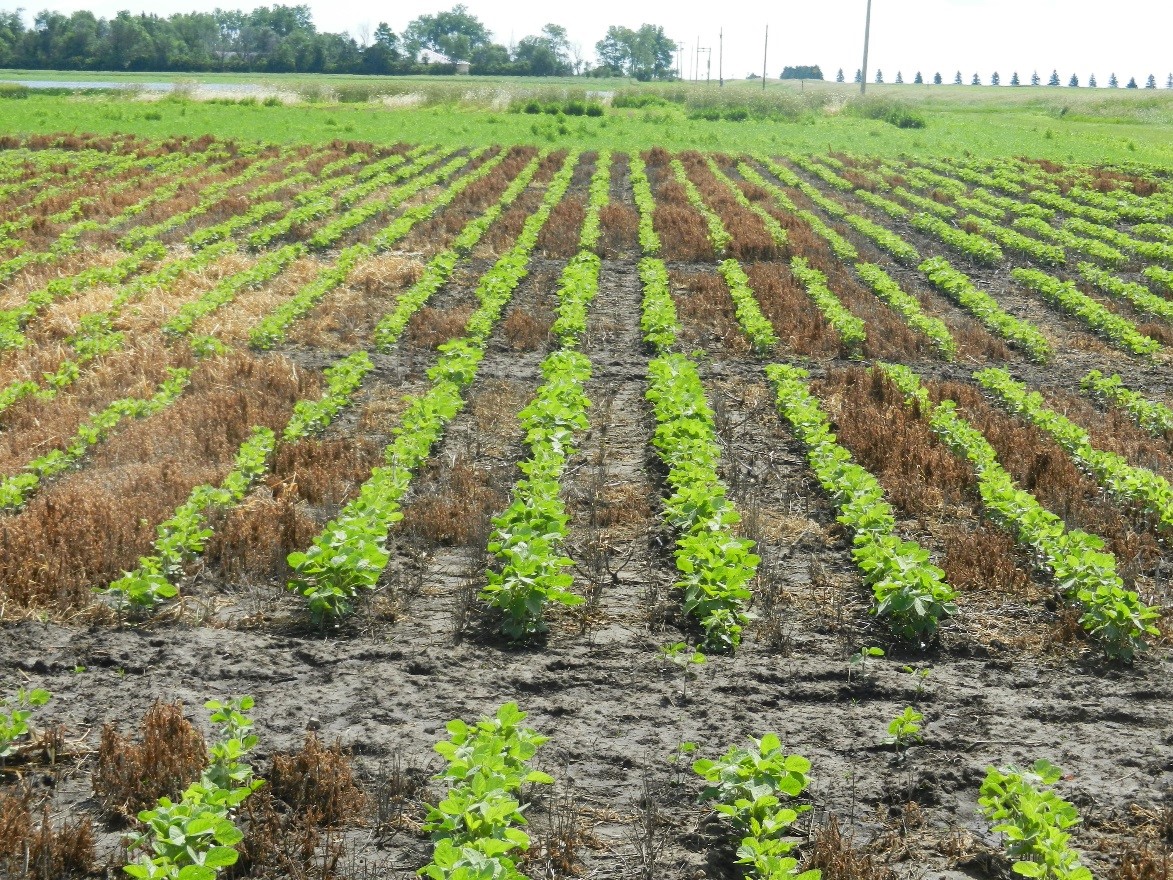
A kochia control trial at the CREC.
Mike Ostlie
Agronomist
Review of CREC Field Day
The 2014 CREC Field Day took place on Tuesday, July 15. The weather conditions for the day were perfect as the day’s temperatures hovered around 70 and the winds were minor. These conditions were certainly welcome since recent CREC Field Days have often experienced mid-day temperatures in the upper 80’s! The excellent weather along with what we feel was a solid educational program resulted in a large audience with people coming from across a wide region.
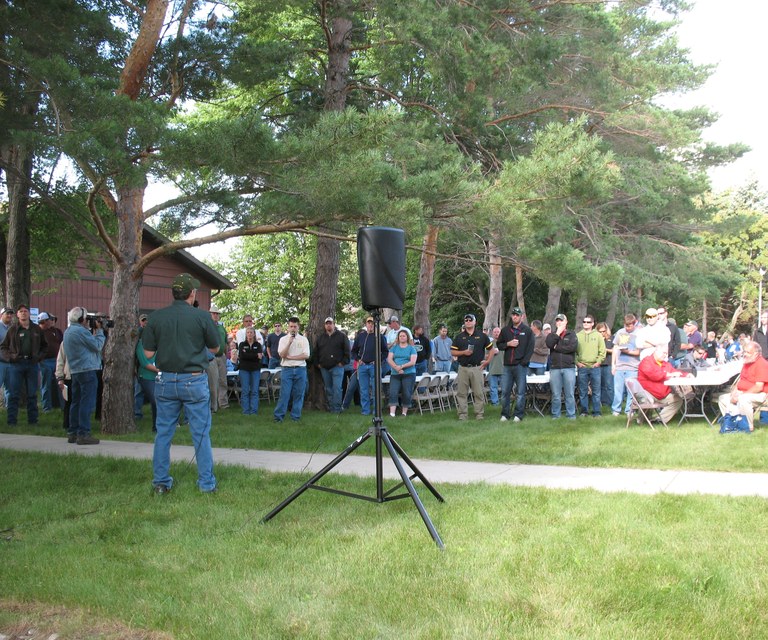
The morning tours were well attended with over 300 participants on the four tours. The crop variety and production tour highlighted kochia management in soybean, corn development and N fertilizer recommendations, timing of weed control in corn and soybean, soybean production research and recommendations, managing white mold in dry bean and soybean, sulfur fertility in corn and wheat, and barley and spring wheat variety updates. Please check our website in the coming days at www.ag.ndsu.edu/CarringtonREC/videos for videos of the various agronomy tour presentations. The livestock tour focused on cow herd profitability, reducing breeding costs, whole-farm forage resource management, drylot cow production, manure as a resource, producer feedout results, fodder beets for feedlot finishing, corn particle size in finishing diets, fat levels in distillers grains, corn tempering methods for cattle diets and UAS in livestock research. The organic research and education tour presented organic wheat breeding at the University of Manitoba, organic oat production, North Central SARE programs, buckwheat varieties and their role in sustainability, cow pea and field pea varieties, ancient grains project, organic dry bean breeding at the University of Minnesota, using winter rye as a weed suppression crop and einkorn accession evaluation. The Northern Hardy Fruit tour was especially well attended as participants came from across North Dakota and surrounding states. The agenda featured a walking tour of 13 fruit crops and a presentation by Dr. Bob Bors of the University of Saskatchewan on haskaps and hardy cherries.
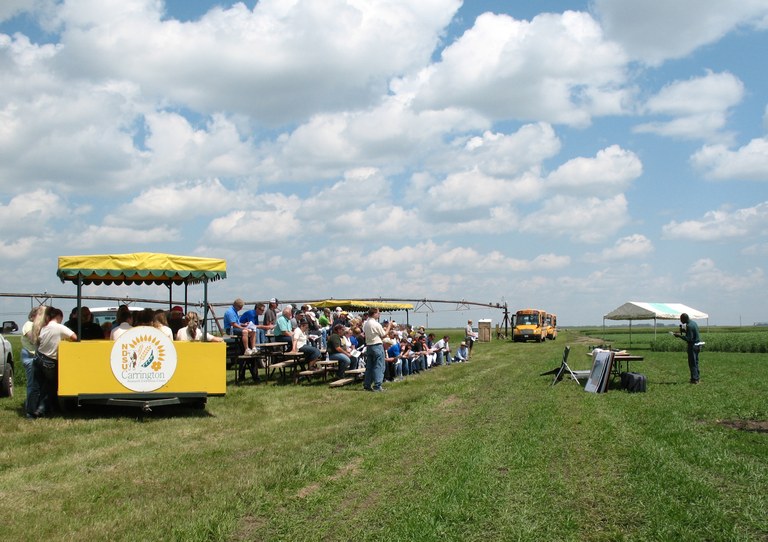
Tour participants enjoyed a lunch served by the Chieftain Conference Center and made possible by sponsorship from the Northarvest Bean Growers Association, the Northern Canola Growers Association, the Northern Pulse Growers Association, the North Dakota Wheat Commission and the North Dakota Barley Council.
The afternoon program, ‘Unmanned Aircraft Systems in Agriculture’, focused on a new research collaboration at the Center. The tour agenda provided updates on this project that is designed to verify the effectiveness of UAS-mounted sensors to assess field crop and livestock management challenges. The tour began with John Nowatzki of NDSU’s Ag and Biosystems Engineering department reviewing the objectives of the proof-of-concept project. The group then heard from Nick Flom of the John D. Odegard School of Aerospace Sciences at UND discuss the logistics of gathering information for the project. The UND flight team conducted a series of UAS research flights among trials near the field where the tour was conducted. CREC researchers reviewed aerial imagery data gathered and compared that with ground-based observations. Lt. Governor Drew Wrigley and Robert Becklund then discussed the significance of North Dakota being one of only six UAS test sites in the nation and the first to initiate test flights. They both shared how agriculture will play an important role with this evolving technology.
We would like to thank those of you who were able to attend for joining us and welcome everyone to give us a call (701.652.2951) anytime you would like to stop by and see what's new at the Carrington REC!
Blaine Schatz
Director & Agronomist
Plant disease management research at the Carrington Research Extension Center
The Carrington Research Extension Center maintains a vigorous plant pathology program with the goal of developing more effective and profitable crop disease management strategies for North Dakota producers.
Plant disease management studies are currently underway to:
- improve recommendations for fungicide application timing in key foliar diseases
- develop crop rotation recommendations for several soil-borne diseases that are difficult to manage with other practices
- facilitate the development of crop varieties with greater resistance to key diseases
- identify the interaction between specific agronomic practices and subsequent disease pressure for several important diseases
- evaluate the comparative efficacy of registered seed treatments and to screen new (experimental) seed treatments for efficacy
- evaluate the comparative efficacy of registered foliar fungicides and to screen new (experimental) foliar fungicides for efficacy against key diseases.
Plant pathology studies are being conducted on a wide breadth of crops grown in North Dakota; current efforts are focused on soybeans, dry edible beans, and several important broadleaf crops grown primarily in western North Dakota, including chickpeas, field peas, and lentils, and work is also being conducted on corn, spring wheat, barley, sunflowers, canola, alfalfa, and safflower.
To help transfer findings from studies to producers and crop advisors, results from key studies are available online. Fungicide efficacy data are currently available online for key diseases on multiple crops, and results from other studies - including studies evaluating seed treatments, fungicide application timing, and the impact of specific agronomic practices on disease - will be posted online in future years. Fungicide efficacy results are available at http://www.ag.ndsu.edu/CarringtonREC/plant-pathology or by searching for the Carrington Research Extension Center and clicking on the "plant pathology" link at the upper left-hand corner. Results are organized by crop and, within each crop, by disease. Where an extensive number of studies have been conducted, results within each disease are organized by registered fungicide and interpretive summaries on the efficacy of each fungicide are included. Most reports are presented in two formats: a user-friendly format with key results presented visually with bar graphs, and a technical format with full results presented in a table.
An example of Sclerotinia stem rot of lentils.
Photos like this and more can be found at http://www.ag.ndsu.edu/CarringtonREC/plant-pathology.
The Carrington Research Extension Center's history as an irrigation research center has proven invaluable for the current disease management research efforts. Disease management strategies can only be studied if the crop disease develops, and many of the most important crop diseases in North Dakota develop during wet weather. The research center has excellent irrigation infrastructure, and this infrastructure has permitted the development of extensive micro-irrigation efforts designed to deliver appropriate amounts of water at key crop growth stages to facilitate disease development even when rainfall patterns are not conducive to crop disease development.
Michael Wunsch
Plant Pathologist
Discovery Farms Program – An update from the Discovery Farm in Underwood, ND
The idea for Discovery Farms was first formulated and implemented in Wisconsin to address the concerns that environmental and water quality regulations were inconsistent with profitable agricultural production.
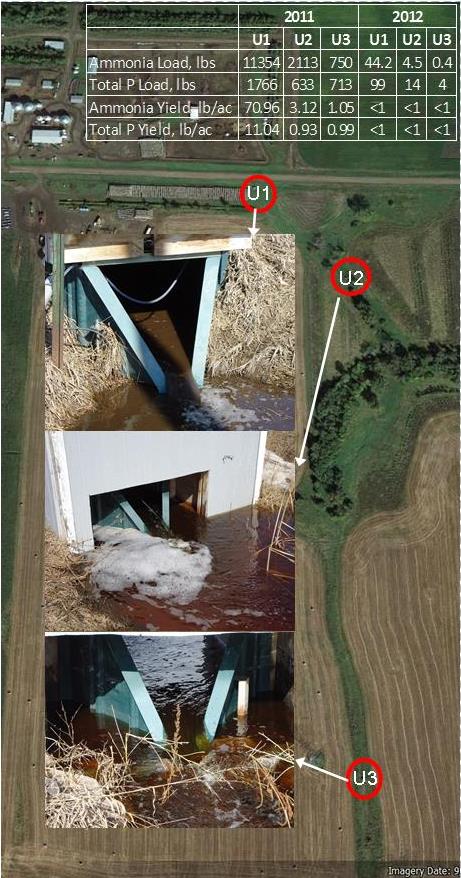
Similar concerns also exist in North Dakota. Farmers, ranchers, researchers, policymakers and governmental agencies in the state recognize that a balance must be reached between the maintenance of agricultural profitability and the implementation of regulations and policies that protect our natural resources. The Discovery Farms project will provide a working farm setting to collect the data needed to help these decision makers strike that balance. A Discovery Farm is a working farm or ranch voluntarily cooperating with the project to demonstrate and evaluate the effectiveness of best management practices (BMPs) at reducing environmental impacts. Currently there are 3 farms enrolled on the ND Discovery Farms Project (Underwood, Dazey and Sheldon). Each Discovery Farm addresses specific grass-roots issues that are important to the cooperating producer and the region of the state where they are located.
In 2007, NDSU, USGS, ND Department of Health and the farmer cooperator, started a Discovery Farm project near Underwood (McLean Co.). Water samples were collected between April and October from 2008 through 2012 and analyzed for selected attributes, which were used to describe water-quality in runoff and to estimate nutrients and sediments’ annual loads and yields.The following is a brief summary of the results found:
-
- Concentrations of chloride, nitrate + nitrite, and total nitrogen were not significantly different along the waterway;
- Annual loads varied by year, in response flow volume (2011 rainy year and 2012 dry year), and by site location on the landscape (higher loads at the U1 and lower loads at U3) (table on top of the picture);
- In 2012 the yields for both TP and Ammonia in the runoff where <1 lb/ac in all sites. The highest yields in the runoff where found in 2011 at U1 for both TP (11 lb/ac) and Ammonia (71 lb/ac).
- In 2012, a clean water diversion system was built around the feedlot to decrease the amount of water moving through the feedlot area, especially during snow melt in the spring. The water quality monitoring is still on-going and will continue for a couple more years to assess the effectiveness of the BMP (clean water diversion system) proposed by the farmer collaborating on this project.
Today there are Discovery Farms project in four states (WI, ND, MN, and AR). Click on the links to learn more about the Discovery Farms in those states.
Paulo Flores
Nutrient Management Specialist
CREC Field Day
Greetings! We invite you to attend the Carrington Research Extension Center’s Annual Field Day on Tuesday, July 15.
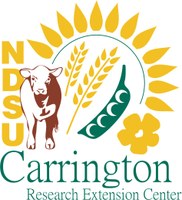
CREC Field Day is our opportunity to ‘show off’ all the great things that are happening here. While the Center is always open for guests, we work especially hard during the week prior to Field Day to make certain everything is in good order.
The day begins with a welcome and refreshments at 9 a.m. Tours will leave the yard promptly at 9:30 a.m. We are expecting larger crowds than usual this year, so please plan to come early.
The morning tours will run concurrently and include an agronomy tour, livestock tour, organic/sustainable agriculture tour and a Northern Hardy fruit and berry tour.
The agronomy tour will focus on a variety review of spring wheat, barley variety review and industry changes, corn crop development and N fertilizer recommendations, soybean production and management updates, weed management strategies in soybean, sclerotinia in dry bean and soybean, and sulfur fertility research in corn. The organic/sustainable agriculture tour will include discussions of the University of Manitoba organic wheat breeding program, organic oat production, grants and programs from North Central Region SARE, sustainability of buckwheat varieties, cow pea varieties, field pea varieties for organic systems, ancient grains project update, organic dry bean breeding, and using winter rye as a weed suppression crop. The Northern Hardy fruit tour will include an overview of all the fruits in the orchard and a presentation by University of Saskatchewan domestic fruits researcher Dr. Bob Bors. The livestock tour will include discussions of cow herd profitability, reducing breeding herd costs, forage resource management, using corn stover in drylot cow production, using manure as a resource, producer feedout results of the Dakota Feeder Calf Show, and feedlot research with industrial beets, corn, distillers grains and unmanned aerial systems.
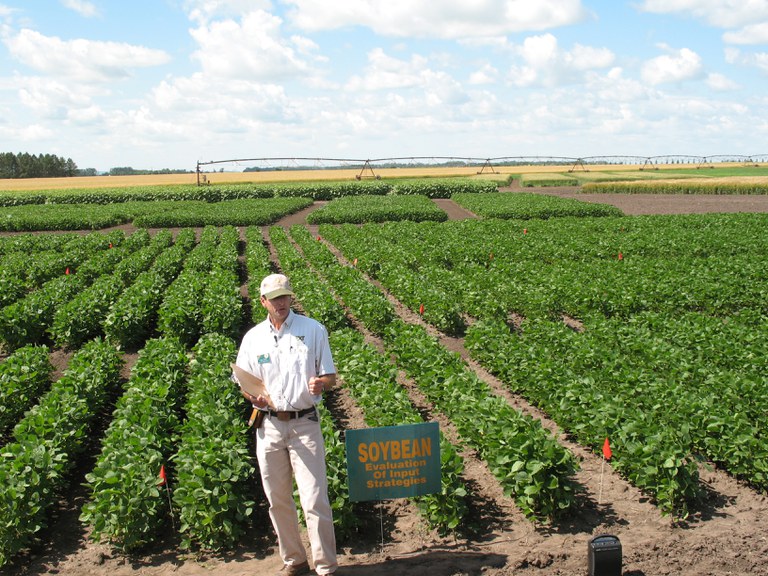
Morning tours will be followed by a noon lunch and an afternoon tour focusing on the research project “UAS Applications to Agriculture.” This tour will include a review of the project, review and discussions of the imagery data collected, displays of the UAVs used in the project and commentary from UND Flight Operations collaborators, private partners, and the Northern Plains UAS Test Site.
Field Day will be held on July 15, come rain or come shine, but some of the presentations may be moved indoors if the weather dictates. Of course, all of the presentations and the noon meal are free and open to the public, and you are welcome to attend as much or as little of the day’s activities as you desire.
We hope you will join us on July 15. If you choose to visit us at any other time of the year, please adhere to these guidelines to ensure your safety and preserve our research. (1) Check in at the Main Office in case there are any projects that wouldn’t be safe for you or so that you don’t accidentally interrupt our work or a scheduled tour. (2) Please stay in your vehicle. (3) Watch where you drive. Our trails can be soft after rain, and some plots are planted very close to trails. (4) Please don’t disturb anything or take anything. Remember, we are conducting research and need to monitor what’s goes in, on, and out of our plots.
Please call us with questions at 701-652-2951. We will find an expert to help you.
Linda Schuster
Administrative Secretary
North Dakota Farm Business Management at the CREC
The Carrington Farm Business Management Program is a collaborative effort by the Carrington Public Schools and the North Dakota Career and Technical Education Department that is housed at the Carrington Research Extension Center.
The program is one of 15 through the state and consists of two instructors working with roughly 85 clients operating farming and ranching enterprises in central North Dakota. The farm management program is designed to help farmers and ranchers set and formulate goals for their operations, increase their general knowledge of items involved with management, and to do an analysis of the farm or ranch each year to measure their progress towards their goals as well as improve the ability to make management decisions based on benchmarks measured in the analysis.
Below you will find some of the highlights from the 2013 analysis of 74 farms enrolled in the Carrington program:
- Farms enrolled in the program were made up of an average of 2,650 crop and hayland acres plus 467 acres of pasture.
- The average net farm income was $216,633 and the median net farm income was $128,931.
- The average farm borrowed $1,106,898 while making principal payments of $1,013,272.
- The average farm spent $0.71 for every $1 of income generated while the high profit farms spent $0.65 and the low profit farms spent $1 to generate $1 of income.
- Pinto beans led the way for crops with a net return on rented land of $337.58/acre, including government payments. They were followed by barley at $203.44/acre, soybeans at $128.14/acre, prevent plant at $64.59/acre, spring wheat at $54.20/acre, and corn at -$47.12/acre.
- Cattle recorded an average net return per cow of $236.61.
- The following pie charts show where all of the cash inflows and outflows came from in 2013. $1,243,433 was the average cash from income while $804,083 was the average cash expenses.
Expenses
Income
You can find more detailed publications and information at www.ndfarmmanagement.com. You may also contact Steve Metzger or Jory Hansen for further discussion or if you are interested in enrolling your farm or ranch.
Jory Hansen
Farm Business Management Instructor
Weekly Crop Updates – Facebook and Crop & Pest Report
Two sources of weekly crop updates are available from the Carrington Research Extension Center.
- Facebook: Weekly notes are placed on the ‘NDSU Extension Service – CREC Agronomy’ page. Information includes crop and trial status (during growing season), research and recommendation briefs (primarily during winter), and tour/meeting announcements. As an example, the entry posted on June 6 was a picture and narrative regarding corn as a poor choice for production on salt-affected soils. Please ‘like’ the page, which can be found at www.facebook.com/NDSUExtServ.CRECagronomy.
- NDSU Crop and Pest Report: Weekly updates on south-central ND crop development and pest incidence are published in the ‘Around-the-state’ section of this publication. As an example, the following is the article for June 12.
The region’s NDAWN stations indicate rainfall ranging from less than 0.1 inch (Jamestown) to 0.5 inch (Oakes) during the past week (June 4-10). In general, the region has adequate soil moisture. As of June 10, corn planted on May 15 has about 80-110 accumulated growing degree day units greater than the 5-year average for the period. Alfalfa is in the bud to early flower stages (see picture). Winter wheat is beginning to head – time to prepare for application of early flower fungicide. Early seeded small grain is in the 4 leaf to jointing stages. The recent cool weather will help increase spikelet number in wheat and barley heads - increasing yield potential. First-half of May planted corn has 4 collared leaves (V4 stage). Soybean and dry bean planting is near completion, while sunflower planting continues. Early planted soybean have 1-2 trifoliate leaves (V1-2 stages). Besides finishing planting, main farm activity is application of POST herbicides. There still are a few fields of corn from 2013 left to be harvested.
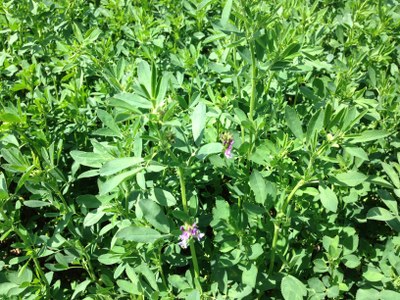
The Crop and Pest Report is electronically released each Thursday during the growing season. Subscription is free and can be obtained by accessing this website: www.ag.ndsu.edu/cpr/. You can also receive the information by ‘liking’ the Facebook page: www.facebook.com/ndsuextcpr.
Greg Endres
Area Specialist, Cropping Systems


